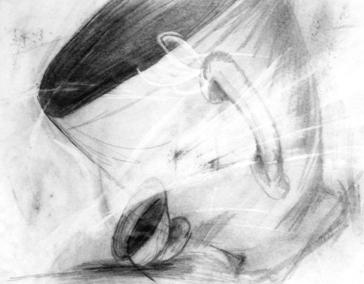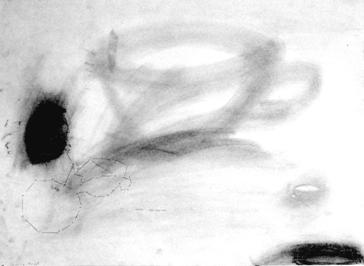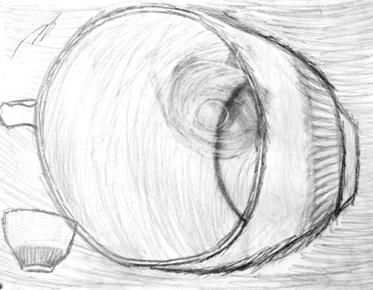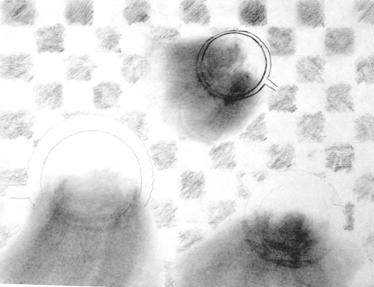| tabula congratulatoria | |||||||
|---|---|---|---|---|---|---|---|
Julian, June |
|||||||
2014 Author’s Note:
|
|||||||
The Ladder and the Mattresses:
|
↑ |
Meta-Theory |
↓ |
Theory |
||
Meta-Criticism |
||
Criticism |
||
Art Experience |
Figure 1. Ecker & Kaelin’s
Levels of Discourse in Aesthetic Inquiry
Let’s begin with the art object/event as the basis of our inquiry and select one of three options: engaging in a verbal critique, writing text, or creating another art object, as a response. But, for whatever medium we choose for our critique, we need a method.
Using Phenomenology as our Critical Method
Here are four drawings by my high school students from a project titled:
Beyond the Teacup. (See Appendix)As art objects, they are positioned at the base of Ecker and Kaelin’s ladder. We begin at step 2 on ladder, which is criticism. I suggest that we begin with writing a short text using phenomenology as our method. A school of philosophy led by Edmund Husserl, phenomenology can be used as a method of describing the experience you are having, without explaining it or making hypotheses. In Husserlian phenomenology it is not necessary to interpret the art object/event, nor draw conclusions about it (Husserl, 1962). Let us begin now by having an art experience in Time 1, writing about it critically in Time 2, and in Time 3 reducing our writing to its essential features as meta-criticism.
Procedure
Time 1 Art Experience
Select a student drawing and attend carefully to it, trying to block out all outside stimuli. In his Aesthetics for Arts Educators, Kaelin calls this performing an epoché or ‘bracketing out” the outside world and limiting our attention to the art object/event as it appears to us (Kaelin, 1989).
Time 2 Criticism
For several minutes write descriptive text about your experience.
Time 3 Meta-Criticism
Now perform Husserl’s Phenomenological Reduction: Reduce your writing to the essentials. Delete details that are not essential features of the art experience.
The Studio Practice Option
Both the ladder and that iconic pea under the mattresses give us a good way to schematize aesthetic discourse. Using phenomenology as a method to write descriptive text is one way among many others to engage in critical discourse about an art object or experience. What I’d like to suggest here, too, is that it is also possible to engage in studio practice in response to an art experience. For example, my doctoral research, A World Community of Old Trees, a continuing ecology art project on the Web, is a meta-critique in process of my critique of earlier ecology projects on the Internet
(Julian, 1998). Embedded in it are paintings, drawings, photographs and multimedia as well as text.
How then can criticism be an actual art piece? Can meta-criticism be made of paint or steel as well as words? Why can’t those rungs on the ladder be an art piece all its own? Let’s do the following exercise to see how it works.
Drawing as Meta-Criticism
The meta-critique of the critique of the source art object can be in the form of more art. This happened quite nicely in my Web research in the Student Projects section where one of my students invited the world to respond to his page in the Web project by manipulating his imagery and adding it to his pages (Julian, 1997).
We can do this now by actually drawing our meta-critique with pencil on paper. This means that we may make our own teacup drawing as meta-criticism of the student teacup drawing we experienced and critiqued with text.
Procedure
Please produce a drawing as meta-critique of your selected Beyond the Teacup student drawing in the next 10 minutes.
In the time that remains in the class, volunteers may read their critiques and show their meta-critique drawings. Students may also place both exercises on their desks and the class may walk around and view the work.
Toward Theory Building
A natural response to this activity might be the beginning of theory building, Step 4 on the ladder, or the third mattress up. Students might view the text and drawing samples as data and make hypotheses based on their observations. Criticism of any fledgling theory about our Beyond the Teacup universe of aesthetic discourse would fit at the top of the ladder at Step 5 Meta-theory.
I hope that images of the ladder and the mattresses, and these exercises will help you schematize your thinking and talking about art. Whether you select phenomenology or any other philosophical method for navigating through the levels of aesthetic discourse: criticism, meta-criticism, theory, or meta-theory, I believe that an artist educator always has the option of utilizing studio practice at each of those positions. This is how new generations of thoughtful art objects and events are born and how the cycle of aesthetic discourse itself is renewed.
References
Ecker, David W. and Kaelin, E.F. (1972). The limits of aesthetic inquiry: A
guide to educational research. In Philosophical redirection of educational research.
Husserl, Edmund. (1962). Ideas. New York: Collier Books. (Original Work
published in 1913).
Julian, J. (1997). A world community of old trees. Retrieved from
http://www.nyu.edu/projects/julian/josh.html
Julian, J. (1998) Art education online: A world community of old trees: A
story of the research. Retrieved from http://www.nyu.edu/projects/julian/research_story.html
Kaelin, E.F. (1989). An aesthetics for art educators. New York: Teachers
College Press.
Appendix
Beyond the Teacup, High School Student Drawings



